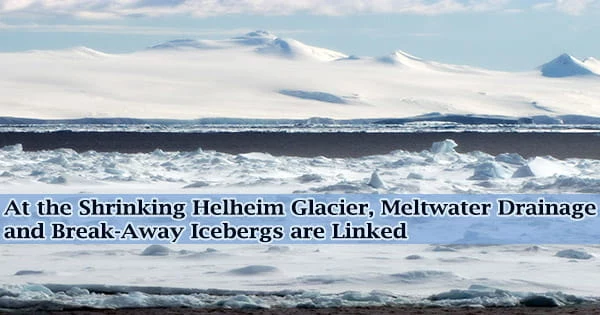According to a Penn State-led team of scientists, dark patches of the open sea that develop in the ice-choked water around Helheim Glacier may give fresh information about how a fast-changing Greenland glacier loses ice.
“Greenland is losing a lot of ice, and it drains from the interior of the ice sheet to the ocean through outlet glaciers like Helheim,” said Sierra Melton, a doctoral candidate in geosciences at Penn State. “Understanding what’s happening at these glaciers is important.”
During warm seasons, enough meltwater drains from beneath Helheim, causing plumes of buoyant freshwater to rise to the surface of the sea in front of the glacier, visible as patches of open water, according to scientists.
The scientists discovered that while the plumes were visible on the surface, big icebergs stopped breaking away, or calving, from the glacier near the plumes, using satellite and time-lapse photographs.
“We’d see a lot of calving happening, and then it would stop when the plume was visible and start again after the plume disappeared,” Melton said. “And when calving did occur, it happened away from the plume. They were always separated by space and time.”
Large chunks of ice break off from behind the rock at the front of the glacier, which can be up to 300 feet tall in some places, during calving at Helheim. Like bigger Antarctic glaciers, Helheim used to finish in a floating extension known as an ice shelf or ice tongue, but that ice has already broken off and melted, revealing the cliff.
Greenland is losing a lot of ice, and it drains from the interior of the ice sheet to the ocean through outlet glaciers like Helheim. Understanding what’s happening at these glaciers is important.
Sierra Melton
According to scientists, calving accounts for nearly half of the ice loss from the Greenland Ice Sheet and is a substantial contributor to sea-level rise.
“Sierra’s work, including this paper, is an important contribution to the larger effort to understand how iceberg calving really works and what controls its speed, so we can do a better job of projecting what will happen in Greenland, as well as Antarctica, and what that will mean for sea-level rise and costal people,” said Richard Alley, Evan Pugh University Professor of Geosciences at Penn State, Melton’s adviser and a co-author on the paper.
While the link between plumes and calving has been noted before at Helheim, direct observations are difficult due to inaccessible terrain on the glacier and ice in the sea.
From 2011 to 2019, the scientists used high-resolution satellite photographs and hundreds of time-lapse photos from cameras stationed around the glacier to perform a more extensive analysis.
The findings, published in the Journal of Glaciology, imply that the link between meltwater outflow and calving is caused by changes in hydrology and pressure beneath the glacier.
Water begins to collect in crevasses and form lakes on the glacier surface during melt season. According to the experts, some meltwater sinks to the glacier bed, where it begins to fill cavities and establish a network between them.
“The way a subglacial drainage system evolves is if there’s not very much water under the glacier, then there is low water pressure,” Melton said. “As the water increases under the glacier, the pressure starts to increase with it.”
The speed of the glacier’s march toward the sea increases as more water flows to the bottom and the water pressure rises, the scientists said, and fractures can emerge in the ice, making it more vulnerable to calving.
However, if enough water is present at the glacier bed, the water can eventually carve channels in the ice’s bottom that route meltwater into the sea, acting as a kind of relief valve that lowers the water pressure beneath the ice, according to the scientists. These conduits can release enough freshwater to cause plumes to appear on the sea’s surface.
“We think this lower pressure configuration inhibits the large calving because the fractures in the bottom of the ice can’t form,” Melton said. “So basically, the system that supports the plume existence should suppress the calving.”
Sridhar Anandakrishnan, a professor of geosciences and Melton’s co-adviser, and Byron Parizek, a professor of mathematics and geosciences, both contributed from Penn State.
Leigh Stearns, associate professor and Michael Shahin, doctoral candidate, at the University of Kansas, and Adam LeWinter, physical scientist, and David Finnegan, director of remote sensing, at the Cold Regions Research and Engineering Laboratory, also contributed.
The National Science Foundation, the Natural Environment Research Council of the United Kingdom, and the Heising-Simons Foundation funded this study.





